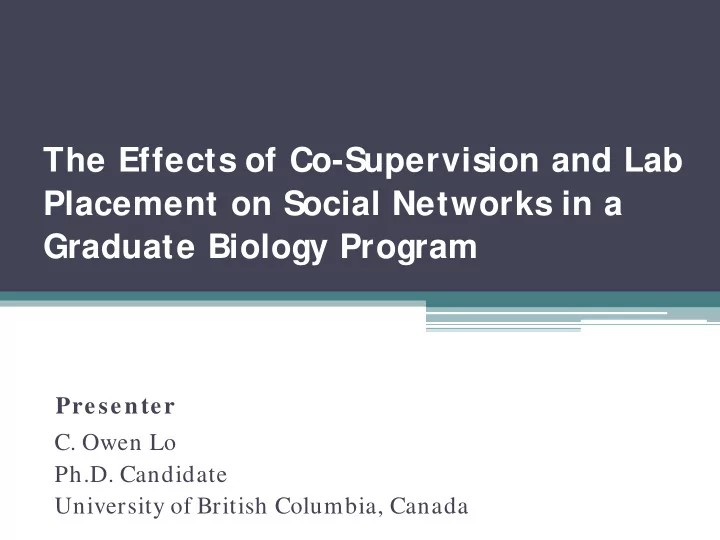

The Effects of Co-Supervision and Lab Placement on Social Networks in a Graduate Biology Program Presenter C. Owen Lo Ph.D. Candidate University of British Columbia, Canada
Presentation Outline Introduction General Social Network Consulting Social Networks Com m ents & Feedback
Working on Walls (WOW) Proj ect • Part of an NSERC-CREATE endeavor ▫ Canadian governmental funding ▫ 6-year project • Focuses on plant cell wall studies ▫ Interdisciplinary ▫ 8 faculty members, 3 post-doc fellows, 8 trainees
Data collection & Analysis • Data collection ▫ Electronic Questionnaire: LimeSurvey ▫ April 11 to May 11, 2011 ▫ 19 surveys were collected • Data analysis ▫ UCINET 6 (maps and statistics) ▫ SPSS (statistics)
General Questions • What is the pattern of the 1) general social network, and 2) consulting networks? • Have co-supervision and lab-placement increased the network interaction? and have the professional-development activities increased the network interaction? • What are other factors that might have influenced the network interaction?
Pattern examination of the WOW social interaction • Cut-point: zero • 2-step: all nodes • Core-peripheral index: 0.48 Density m atrix- WoW network Core Peri. Core .8 7 .41 Peri. .41 .20
General traits of the WOW social interaction • Overall density: 0.65 • Reciprocity: 65 % • Average ties: 12.5 • Incoming: 11.1 • Outgoing: 10.1 • EI indexes: • 0.23 (rank) • 0.73 (primary lab) * Colors denote rank titles
Co-supervision, lab-placement & the general interaction Correlations: • with supervision matrix r = .26 (p < .001) • with lab-placement/ co- supervision matrix r = .45 ( p < .001) t-test: Z= 1.94 ( p< .05, one tailed) * Colors denote various laboratories
Professional development & the general networking Density PIs PDFs Trs. PIs .75 PDFs .37 1.0 Trs. .53 .83 .93 * Color denotes rank
A logistic regression model IV B Std. df Sig. • Dependent variable: Err. Power distance -.158 -275 1 <.001 171 possible ties among 19 nodes (dichotomous) Any lab-association .207 .221 1 <.001 Aggregated sociability 2.760 .509 1 <.001 Cox & Snell R² = .476, correct prediction rate: 89% • Independent variable: power distance lab-association aggregated sociability gender difference linguistic closeness
General traits of the problem-solving consulting network ? • Density: 0.18 ▫ incoming ties: 3.3 ▫ outgoing ties: 3.8 • Reciprocity: 17% • E-I index: 0.44 ▫ internal ties: 30 ▫ external ties: 78 PIs PDFs Tr. 0.30 0.13 0.05 PIs 0.21 0.50 0.00 PDFs 0.23 0.38 0.14 Tr. * Colors denote various laboratories
General traits of the new idea consulting network ? • Density: 0.14 ▫ incoming ties: 2.5 ▫ outgoing ties: 3.1 • Reciprocity: 20% • E-I index: 0.30 ▫ internal ties: 28 ▫ external ties: 52 PIs PDFs Tr. 0.30 0.13 0.05 PIs 0.21 0.50 0.00 PDFs 0.23 0.38 0.14 Tr. * Colors denote various laboratories
Co-supervision, lab-placement & the consulting networks? r = .74 Correlations Correlations • with supervision matrix • with supervision matrix r = .32 (p < .001) r = .43 (p < .001) • with lab-replacement/ co- • with lab-replacement/ co- supervision matrix supervision matrix r = .27 ( p < .001) r = .29 ( p < .001)
Acknowledgement • The authors would like to extend their appreciation to the Natural Sciences and Engineering Research Council of Canada for their financial support.
Comments & feedback
Comparison Matrixes Primary lab association Enhanced lab association
Recommend
More recommend